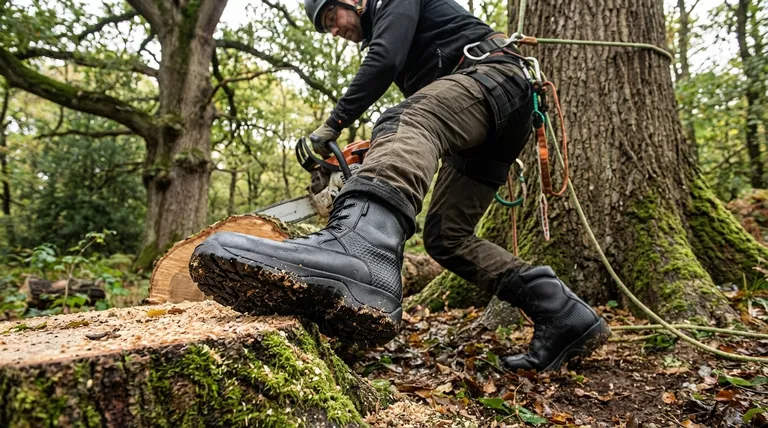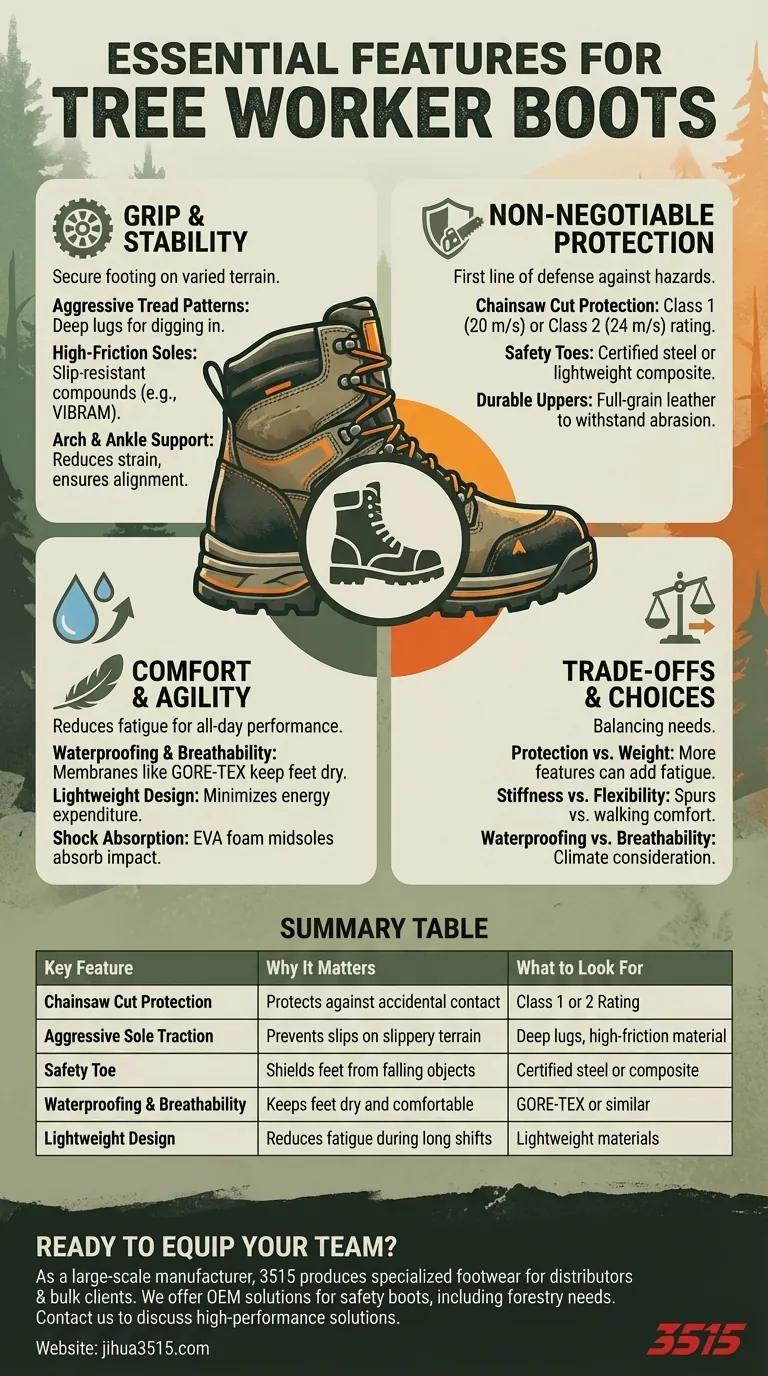The most critical features for tree worker boots are specialized chainsaw cut protection, aggressive sole traction for varied terrain, a certified safety toe, and robust waterproofing. These elements work together to provide the unique blend of safety and agility required for both groundwork and climbing.
A tree worker's boot is not just footwear; it is a specialized piece of personal protective equipment. The right choice moves beyond generic work boot features, balancing non-negotiable protection against the fatigue-reducing benefits of a lightweight, agile design.

The Foundation: Grip and Stability
For a tree worker, secure footing is the bedrock of safety. The ground is often uneven, covered in debris, and slippery from moisture, making the boot's sole your most critical point of contact.
Aggressive Tread Patterns
A deep, aggressive tread pattern is essential. These deep lugs act like claws, digging into mud, loose soil, and bark to provide reliable traction and prevent slips on challenging terrain.
High-Friction Sole Materials
Look for boots with high-quality, slip-resistant soles, such as those made by Vibram. These specialized rubber compounds are designed to maintain a strong grip even on wet, slick surfaces like logs and branches.
Arch and Ankle Support
Long hours spent standing, climbing, and maneuvering demand excellent support. A contoured footbed provides crucial arch support to improve alignment and reduce strain, while a sturdy boot structure supports the ankle during dynamic movements.
Non-Negotiable Protection
Tree work involves constant exposure to severe hazards, from falling limbs to the accidental drop of a running chainsaw. Your boots are your first line of defense.
Chainsaw Cut Protection
This is the single most important feature that separates forestry boots from all other types of work boots. Look for a European Class rating, such as Class 1 (protection up to 20 m/s) or Class 2 (24 m/s), to ensure the boot can resist contact with a running chainsaw.
Safety Toes (Steel vs. Composite)
Protection against falling branches and equipment is mandatory. Both steel and composite toes offer certified impact protection, but composite toes are lighter and do not conduct cold, making them a popular choice for reducing fatigue.
Durable Uppers
The boot's upper material must withstand constant abrasion. High-quality materials like full-grain leather offer superior durability and resistance to wear and tear from branches, debris, and climbing equipment.
Comfort and Agility for All-Day Performance
Safety features are useless if the boots are too uncomfortable or clumsy to wear. Modern boots integrate comfort technologies that directly impact performance and reduce end-of-day fatigue.
Waterproofing and Breathability
Working in all weather conditions requires feet to stay dry. A waterproof membrane like GORE-TEX is critical for keeping water out, while a breathable design or "Climate Control System" allows sweat vapor to escape, preventing discomfort.
Lightweight Design
Every ounce on your feet matters, especially when climbing. A lighter boot reduces the energy required for each step, significantly lowering fatigue over the course of a demanding workday.
Shock Absorption
Constantly moving on hard, uneven surfaces takes a toll on your joints. Look for boots with cushioning midsoles made from materials like EVA foam, which absorb shock and dissipate impact forces.
Understanding the Trade-offs
Selecting the perfect boot involves balancing competing characteristics. Understanding these trade-offs is key to choosing the right tool for your specific needs.
Protection vs. Weight
More protective features, especially higher classes of cut resistance and steel components, inevitably add weight. This can increase fatigue, particularly during extensive climbing.
Stiffness vs. Flexibility
A stiffer sole can be advantageous when using climbing spurs, as it provides a more stable platform. However, that same stiffness can feel clumsy and less comfortable for extensive groundwork or walking.
Waterproofing vs. Breathability
While essential, even the most advanced waterproof membranes can limit airflow. In very hot and dry climates, a non-waterproof but highly breathable boot might be a more comfortable option to keep feet cool.
Making the Right Choice for Your Role
Select your boots based on the primary demands of your job.
- If your primary focus is climbing and aerial work: Prioritize a lightweight design, excellent flexibility, and strong arch support for comfort while in spurs.
- If your primary focus is groundwork and rigging: Emphasize maximum chainsaw cut protection, a durable safety toe, and an aggressive tread for stability.
- If you work in consistently wet or varied climates: Insist on a high-quality waterproof and breathable membrane to ensure all-day comfort and foot health.
Choosing the right boots is a direct investment in your daily safety, comfort, and long-term career resilience.
Summary Table:
| Key Feature | Why It Matters | What to Look For |
|---|---|---|
| Chainsaw Cut Protection | Protects against accidental chainsaw contact. | European Class rating (e.g., Class 1 or 2). |
| Aggressive Sole Traction | Prevents slips on uneven, slippery terrain. | Deep lugs, high-friction materials like Vibram. |
| Safety Toe | Shields feet from falling branches and equipment. | Certified steel or composite toe. |
| Waterproofing & Breathability | Keeps feet dry and comfortable in all weather. | GORE-TEX membrane or similar technology. |
| Lightweight Design | Reduces fatigue during climbing and long shifts. | Lightweight materials without compromising protection. |
Ready to equip your team with boots that meet the highest standards of safety and performance?
As a large-scale manufacturer, 3515 produces a comprehensive range of specialized footwear for distributors, brand owners, and bulk clients. Our production capabilities encompass all types of safety boots and shoes, including those tailored for the rigorous demands of tree work and forestry.
We combine advanced protective features with ergonomic design to ensure durability, comfort, and compliance with industry standards. Whether you need custom branding, bulk orders, or reliable OEM solutions, we deliver quality you can trust.
Contact us today to discuss your specific needs and discover how we can support your business with high-performance footwear solutions.
Visual Guide

Related Products
- Premium Grain Leather Safety Boots for Bulk Supply
- Premium Wholesale Wheat Nubuck Safety Boot with Rapid Lacing System
- Customizable Anti-Smash Safety Boots for Wholesale & Private Label Manufacturing
- Custom Wholesale Leather Safety Boots Direct Factory Manufacturing
- High Performance Fire-Retardant Waterproof Safety Boots
People Also Ask
- Is safety toe better than steel toe? A Guide to Choosing the Right Protection
- What is the OSHA standard for safety-toe boots? Ensuring Compliance and Worker Protection
- Is there a downside to steel toe boots? Weighing Protection Against Daily Comfort
- What is a safety-toe in a boot? Your Guide to Choosing the Right Protection
- What boots do they wear on oil rigs? Essential Safety Footwear for Harsh Conditions



















